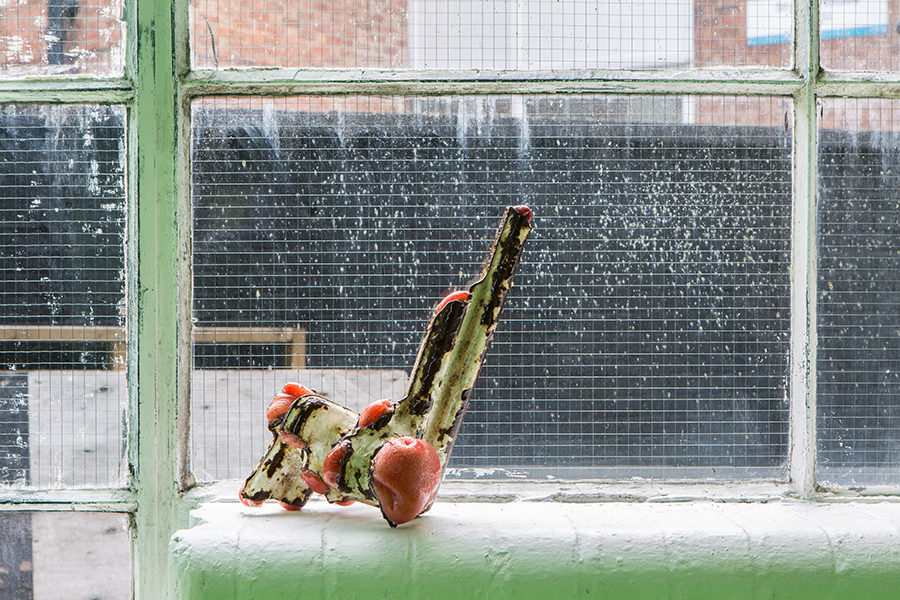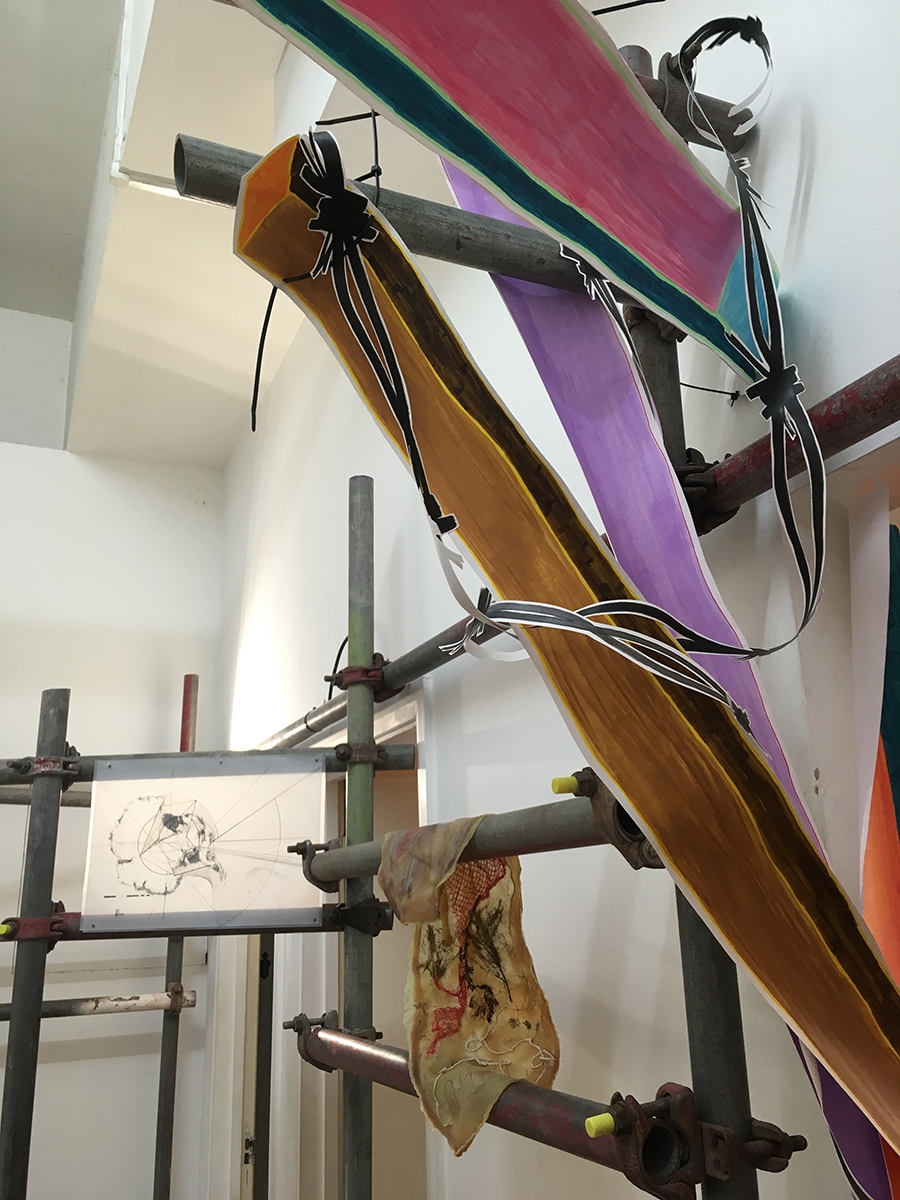Alternative Truths: How Small London Shows Are Reviving Popular Subcultures
From viral slime to medieval botany, these artists are probing the margins of mainstream knowledge
From viral slime to medieval botany, these artists are probing the margins of mainstream knowledge

A snapshot captures a bulbous capsule nestled in the nook of a wall. Coated in shiny film and drifting on a puddle of frothy discharge, the luminous fuchsia detergent pod throbs with synthetic sexiness. Through the photographer’s lens, we survey it with the troubled titillation of a zoologist encountering an errant species. Untitled (2018) by Pinar Marul formed part of ‘physarum borax’, a group show at Platform Southwark last October, curated by Ella Fleck and Bryony James. The photograph resounded with its environment: a fleshy hive of crimson globules in polyester resin sprouted beneath it, starkly lit on an acid-green floor like some microbial evolution. Squirts of detergent skirted the opposite wall like traces of a chemical explosion.
The show’s title denotes a hybrid – physarum is a genus of slime moulds, borax a binding agent used in artificial slime and washing powder. Jack Felgate’s Slug Ascending (2018) depicts a metallic gastropod rising from a spray-painted cloud of pulpy protoplasm, while Iain Ball’s Lutetium Research Council (2018) presents a slice of thick-crust pizza topped with a squashed Tide Pod: a laundry tablet brand that looks alarmingly like jelly. After a YouTube dare to eat the product – the Tide Pod Challenge – spread virally in early 2018, what had begun as a niche parody became a widespread reality. Later, when media outlets broadcast warnings about the potentially fatal risks of ingesting the gel, the gag shifted again, with memes satirizing the mass hysteria sweeping across CBS, NYC and ABC morning news, and certain restaurants actually putting ‘Tide Pod pizza’ on their menus. A joke about a joke about a joke, Ball’s installation opened an infinite loop of narratives between satire and reality, screen and body, online and offline.
In Lara Joy Evans’s video Incomprehensible Slime (2018), a rogue psychologist engages in alchemical play. Swerving, hand-held footage of a makeshift laboratory is accompanied by a voice-over, quivering with the climactic excitement of a pseudo-messiah, which narrates the protagonist’s experiments in ‘self-induced psychoses’. Voluntarily embracing the abject, the psychologist is presented as a kind of sorcerer’s apprentice, grappling inexpertly with the spells cast by a sterile society, as spirited endeavours swerve into self-doubt and ambiguity.

Elsewhere in the show, human forms collapse into states of entropy. A cluster of resin cells percolates a metal frame, swelling and glowing with capricious, fluorescent menace (Jesse Greenberg’s Plate Set, Blue-Green, 2015). A freestanding ceramic gun infested with lacquered boils and resin obliquely points towards the ceiling (Louise Gibson’s Ceramic Atom # 4, 2016). Taking slime as ‘a model for understanding the slippery incoherence of our present condition’, as Fleck and James put it, these artists are blasting the residues of culture back on itself, invoking a transrational experience.
At Jupiter Woods, a collaboration between curator Carolina Ongaro and artists Rebecca Jagoe and Nils Alix-Tabeling is unfolding throughout the first half of 2019 via a series of research proposals and workshops that draw upon early-modern healing practices as a means of mitigating disillusionment. Titled ‘Florilege’ – the anthologizing of flora – the project revives plant lore and herbalism in opposition to modern Western assumptions about the body. The biblical Tree of Knowledge from the Book of Genesis is the linchpin for Jagoe’s workshop. Unpicking the myth that associates eating with knowing – that classifies the body as separate from, and controllable by, the mind – they investigate how the apple became equated with the unnamed fruit of Eden in an attempt to revive disparate folkloric and medicinal histories of fruits. While their entwinement of different readings into a collage text draws upon the associative approaches of natural philosophy and early print cultures, their recitation of the text aloud in a group activity traces back to popular oral performance practices.

In a collaborative project with a herbalist, Alix-Tabeling’s poultice-making workshop will investigate the effects of dead animal-cell secretions on living plant tissues, focusing on toxic chemical compounds widely distributed in the human body – spermine, putrescine and cadaverine, all known for their fetid smells – that have recently been observed to nurture the growth, development and tolerance of plants. Inverting the regular dynamic between patient and remedy, Alix-Tabeling nurtures a complex connection between different life forms, promoting a deep ecology.
Over at IMT Gallery, a procession of walking penises carries a vulva on a sedan chair. A gif by Melanie Jackson for the group show ‘Snow Crash’, curated by Kirsten Cooke, Gallivant (2019) revives the motif of ‘wandering genitalia’ that proliferated as part of late-medieval, northern-European carnival traditions, including secular badges and performative revelry. Set against a pink, spiralling background, the animated creatures rhyme with a pink flower-cum-sea anemone installed close-by: a maquette, also by Jackson. A tribute to the coco de mer – a prehistoric palm nut that flourished along the shores of the Indian ocean – Jackson’s tentacle-creature sprawls vast histories, geographies and disciplines.

Distinguished by its resemblance to female genitalia, the nut, as Jackson notes in her 2014 essay ‘Coco de Mer’, acquired conflicting sacred, aphrodisiac and supernatural properties as it began to be traded internationally in the 16th century. By resuscitating the popular and botanical histories of these organic forms, Jackson, like Jagoe, is weaving alternative routes in and around institutional classifications.
Elsewhere in ‘Snow Crash’, a disorientating close-up of tattooed skin bleeds into a flickering patchwork of timelapse photography. A video installation from an ongoing project by Linda Stupart, After the Ice, the Deluge (2018–19) presents a cameo of the artist scratching ink into their body (originally livestreamed as part of a performance), spliced with clips of mounds exploding, roots crawling, flowers opening. Developed through parallel investigations into Morgellons disease – a poorly understood condition whereby sufferers find crystals and fibres under their skin – and melting polar icecaps, an environmental rupture triggering the release of dormant viruses and bacteria, Stupart’s project refracts a crisis in boundary integrity.
‘I want to fuck you like an animal. I want to macerate you, absorb and metabolize you. I want to make you cry.’ A loose-haired woman aims a rock broodingly at the camera, arms uplifted through bleeding sunlight. Tai Shani’s video I Am Paradise (2017), screened next to Stupart’s projection, features an AI answering back to its creator. Scaffolding intercepts the works with materials evocative of subsistence activities: above Stupart’s, a makeshift cardboard shelter; in front of Shani’s, a ridged steel batten. Dislodging us from our neutral viewing positions, the scaffolding around these works invokes discomfort to challenge the omnipotence of the curator and, by extension, the audience.

‘There are known knowns; there are things we know we know.’ In the back room of ‘Snow Crash’, former US Secretary of Defense Donald Rumsfeld’s clichéd non-answer appears on-screen encircled by a series of garbled yet galvanizing words flashing in capital letters and sacred geometries reminiscent of astrological charts. A video work by Diann Bauer & A.S.T., Politics as Palliative Care of the Species (2019) incites us into vague anti-systemic action whilst remaining resolutely untrustworthy. Elsewhere, a tattered text fragment by Lynton Talbot, We Value Your Continued Creativity and Flexibility (2019), urges us to ‘offer plasticity in the face of crisis’, while a handout, I’m Not a Raisin (2019), also by Talbot, boasts ‘the fluid space of a productive life’ from the perspective of a smug Google veteran.
A US$50 Amazon Gift Card, redeemed for a rooster, haunts Gossamer Fog gallery. Formulated by the neo-medieval art collective Confraternity of Neoflagellants, Voucher Cock is ‘part corporeal, part transaction and part commodity’, functioning like a relic in a speculative crypto-economy. Transmuted into Whale Fall (2019), a film co-authored by 18 artists via the platform Most Dismal Swamp, edited by Dane Sutherland, the Confraternity’s martyr-avatar figure features in a topology that Sutherland describes as ‘the carcass of a fetid dataset’. As it is reembodied, re-employed and re-assessed, Voucher Cock, like all the works in these shows, thrives off sub-superstition, flourishing in the remains of a collapsing informational order.
Main image: Iain Ball, Lutetium Research Council, 2018, slime, 3D printed nylon, Gatekeeper for Humanoids, plastic spray bottles, Coca Cola, Gatekeeper for sprites, Call of Duty Modern Warfare 3, Cheese Pizza, Tide Pods, 38 Reasons NOT to join Corporate America poster, blue tape. Courtesy: the artist and Platform Southwark; photograph: Rob Harris






















